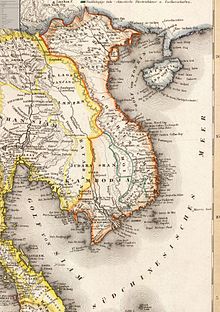Siamese-Vietnamese War (1831-1834)
| Siamese–Vietnamese War (1831–1834) | |||||||
|---|---|---|---|---|---|---|---|
| Part of Siamese–Vietnamese Wars | |||||||
 . |
|||||||
|
|||||||
| Belligerents | |||||||
|
|
|
||||||
| Commanders and leaders | |||||||
|
Trương Minh Giảng |
|
||||||
| Units involved | |||||||
|
|
|
||||||
| Strength | |||||||
| unknown | ca. 50,000 ca 100 warships |
||||||
| Casualties and losses | |||||||
| unknown | unknown | ||||||
The Siamese-Vietnamese War of 1831–1834, also known as the Siamese-Cambodian War of 1831–1834, started when Siam (Thailand) tried to conquer Cambodia and Southern Vietnam, but was repelled by Viet Nam.
After Ang Chan II (1791–1837) retook the Cambodian throne in 1812, Siamese forces moved into northern Cambodia and then southward in support of their own claimant to the throne. The Cambodians were routed at the Battle of Kompong, Chang and Ang Chan fled to Viet Nam in 1832.
Encouraged by their success, the Siamese pushed farther east, capturing the Vietnamese territory of Châu Đốc and Vĩnh Long in southern Vietnam before being confronted by Vietnamese troops and forced to pull back.
In the meantime, a general uprising broke out in Cambodia and eastern Laos (under Siamese and Vietnamese control). The Vietnamese fielded a 15,000-strong army and marched against the Siamese in 1833 with the goal of restoring Ang Chan to the Cambodian capital of Oudong, north of Phnom Penh. The Siamese retreated and Vietnam gained control of Cambodia.
On 19 February 1833, American diplomat Edmund Roberts arrived at the Siamese port of Pak Nam simultaneously with an embassy from Vietnam (known to him as Cochin China under emperor Minh Mạng). Roberts was only vaguely aware of the war, but soon learned the object of mission:
"...no less than to demand the delivery, to them, of the person of the first minister of state, and superintendent of Pegu, and the principalities of Laus and Camboja, whose title is "Chan-phaya-bodin-desha;" he is a "meh-tap," (Thai: แม่ทัพ mother-of-the-army) or commander of the Siamese forces now in Camboja."
...
Wikipedia
